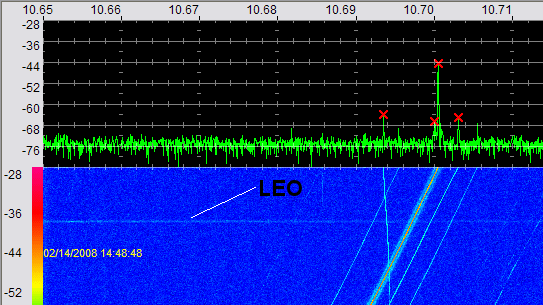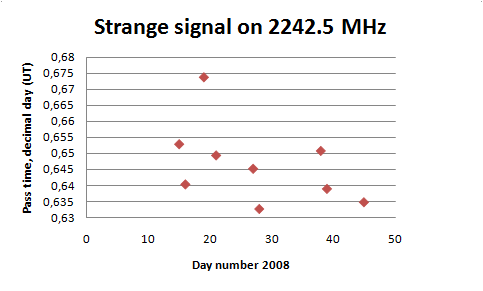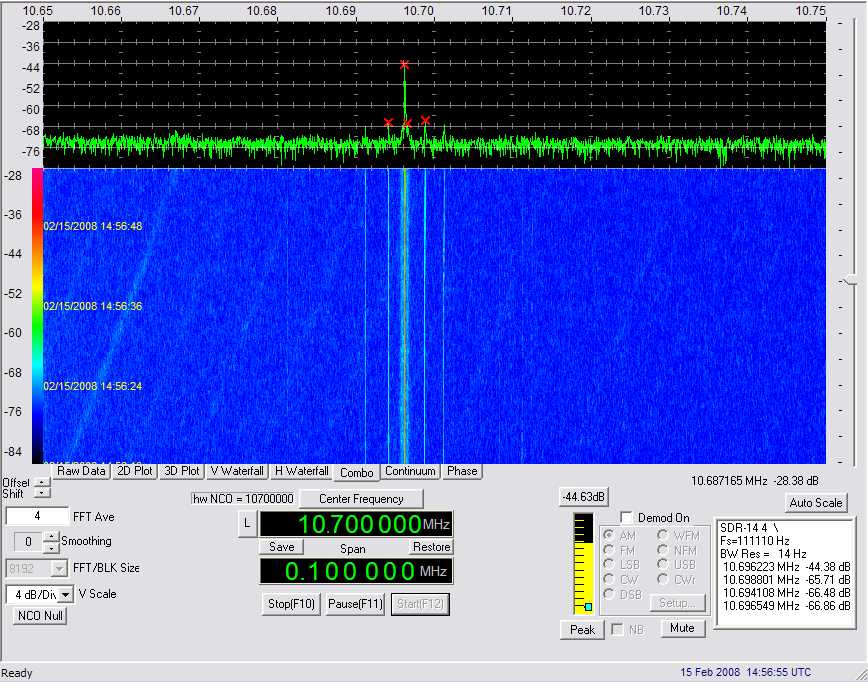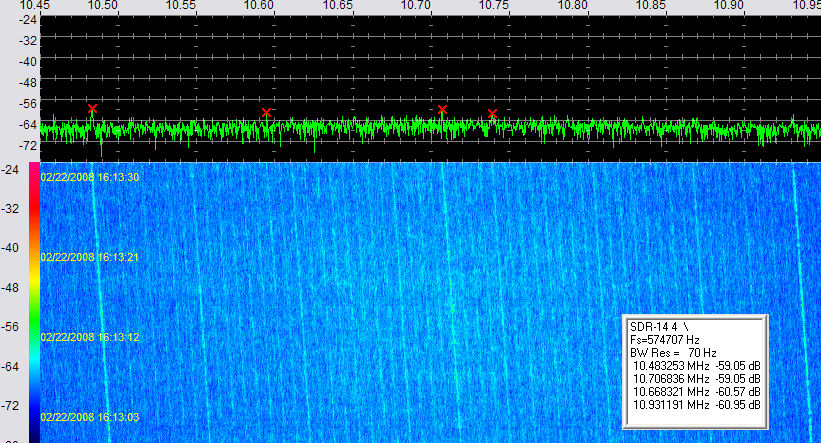Repeated brief, broadband signals on
2242.5 MHz - what they turned out
to be!
Sven Grahn
Strange traces
on 2242.5 MHz
Below is a typical plot that I see almost every day just
after 1500 UT while keeping an eye on the S-band frequency 2242.5
MHz (for details about my tracking setup click here ). That the
horizontal trace is some kind satellite pass, I assumed when I first started seeing it in
January 2008.

Deriving an orbital period
I have noted some logged passes in the table below.
It seems that the signal comes about 17.5 minutes earlier each day, but always
around 1500-1600 UT, i.e. a sun-synchronous satellite, if indeed a
satellite.
| Month
|
Date
|
Day nr
|
Hr
|
min
|
|
UT
|
|
Shift/day
|
| Feb |
14 |
45 |
15 |
14 |
|
0,634722 |
|
|
|
|
8 |
39 |
15 |
20 |
|
0,638889 |
|
-17 |
|
|
7 |
38 |
15 |
37 |
|
0,650694 |
|
|
| Jan |
28 |
28 |
15 |
11 |
|
0,632639 |
|
-18 |
|
|
27 |
27 |
15 |
29 |
|
0,645139 |
|
|
|
|
21 |
21 |
15 |
35 |
|
0,649306 |
|
-17,5 |
|
|
19 |
19 |
16 |
10 |
|
0,673611 |
|
|
|
|
16 |
16 |
15 |
22 |
|
0,640278 |
|
-18 |
|
|
15 |
15 |
15 |
40 |
|
0,652778 |
|
|
|
|
|
|
|
|
|
|
|
|
| N |
12 |
13 |
14 |
15 |
16 |
|
|
| T
|
118,5417 |
109,4231 |
101,6071 |
94,83333 |
88,90625 |
minutes
|
|
| n
|
12,14763 |
13,15993 |
14,17223 |
15,18453 |
16,19684 |
revs/day
|
|
N is integer part of the mean motion.
The two next rows are possible
orbital period and mean motions for the various values of N.
Below I have plotted the passes. They seem to form a "diamond grid"

To test the hypothesis of a sun-synchronous object I tried to
listen on 15 February at a time 17 minutes before the time of the pass on 14 February. And, indeed it turned out to be a low earth
orbit object, but because of the reverse doppler, the frequency is not 2242.5 MHz,
but some other S-band frequency. See waterfall below (the strong signal with
four subcarriers is a high earth orbit object):

With a
little help from my friends
15 February
2008 - sorting out the alternatives
I presented
these observations to the
members of a list server for space trackers and on 15 February 2008 Robert Christy wrote
to the list server
"... Possibilities are:
1 - a single object being being switched on
for one pass per day,
2 - a single object where Sven is seeing only the day's
highest elevation pass,
3 - multiple objects, only one of which transmits
each day with the diamond grid being a freak effect.
My money is on number 2..."
16 February
2008 - signals source identified - Coriolis!
On 16 february 2008 Ted Molczan
wrote on the same list server:
"... A winning bet! The object turns out to be Coriolis
(03001A /27640), a Navy/USAF scientific satellite:
This afternoon, I recalled that
such a satellite had gone up a few years ago into a sun-synchronous orbit. Since
it was military, it might be on SGLS, like DMSP. But, I could not recall its
name. So, I pressed on with efforts to fit a rough mean motion, and found 14.175
rev/d fit all of the observed times. This was similar to one of the values Sven
had determined. So, I was convinced that it was a single object. Final step was
to brute force search the file of all satellites for all instances of " 14.16",
"14.17" and " 14.18", with an eye sun-synch orbits at promising RAANs [Right
Ascension of the Ascending Node]. Within minutes, I found Coriolis, which was
the one I had been trying to recall earlier..."
On the same day I wrote to
the list server:
"...
I tried it again today. I saw the reverse doppler on 2242.5 MHz, but quite
weak. There was nothing on [the frequencies listed for Criolis] 2212.5 MHz
or 2222.5 MHz. BTW,
Paul
[Marsh] lists
both 2212.5 and 2222.528 MHz..."
18 February 2008 - not on a SGLS channel
I wrote to the list server
again on 18 February 2008:
"..I
tuned to the SGLS
channels but could not find the signal. Then tuned back to 2242.5 MHz
and widened the bandwidth, first to 1 MHz and then to 4 MHz . The doppler
was still inverted, but the signal structure showed up. And - it is strong as
hell! I tried to tune around 2242.5 MHz but I fumbled with the tuning step. Next
time I will set the tuning step to 1 MHz and quickly tune up and down flist
server MHz. The signal is wide, so 0.5 MHz or 1 MHz tuning step is no big deal.
The signal strength certainly peaked exactly at the Closest Approach for
Coriolis, so the source is clear...
... there is a direct 'continuous tactical downlink'
at 256 kb/s from Coriolis of wind data to the U.S. fleet on S-band that is
picked up by the shipboard 1.2 meter terminal AN/SMQ-11. Some datalist serverthat the
maximum frequency of this device is 2252 MHz..."
19 February
2008 - frequency determination and confirmation
After
tuning downwards from
2242.5 MHz with a 1 MHz tuning step I finally found a signal with normal doppler
at the time of a Coriolis pass I wrote at 1538 UT on 19 February
2008:
"...Please check this frequency (2221.5 MHz).
Passes over the UK at about 1700 UT. Signal is broadband, about 700 kHz. Quite
strong..."
After the next
pass, at 1705 UT, Paul Marsh wrote:
"... a nice strong signal from Coriolis! 2221.5 Confirmed!
regards, Paul...."
The signal
spectrum
Three days later I recorded
the spectrum below on 2221.5 MHz:

Why the signal on 2242.5 MHz was inverted in frequency
and why a signal on 2221.5 MHz can be observed on 2242.5 MHz remains to be
fully explained.




